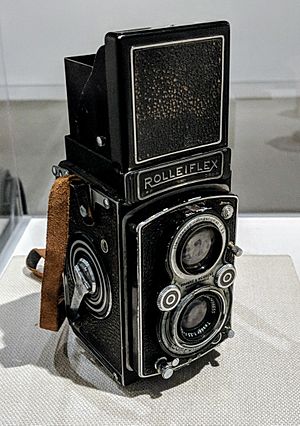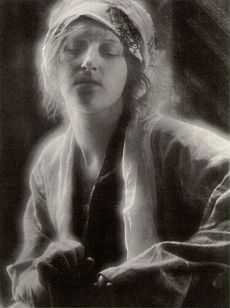Imogen Cunningham facts for kids
Quick facts for kids
Imogen Cunningham
|
|
|---|---|

Self portrait, 1909
|
|
| Born | April 12, 1883 Portland, Oregon, U.S.
|
| Died | June 23, 1976 (aged 93) San Francisco, California, U.S.
|
| Nationality | American |
| Education | University of Washington |
|
Notable work
|
Magnolia Blossom (1925) Triangles (1928) |
| Spouse(s) | Roi Partridge (1915–1934) |
Imogen Cunningham (born April 12, 1883 – died June 23, 1976) was an American photographer. She was famous for her photos of plants and flowers, known as botanical photography. She also took pictures of factories and industrial areas.
Cunningham was part of a group called Group f/64 in California. This group believed in taking very clear, sharp photos of simple things.
Contents
Early Life and Education
Imogen Cunningham was born in Portland, Oregon. She was one of 10 children. Even though art wasn't a regular school subject, she took art lessons on weekends.
She grew up in Seattle, Washington. In 1901, when she was 18, Imogen bought her first camera. It was a special camera called a 4x5 inch view camera, ordered by mail.
In 1903, she started studying at the University of Washington. In 1906, she saw the work of another photographer, Gertrude Käsebier. This inspired her to start taking photos again. She took portraits with her camera. Her chemistry professor, Horace Byers, helped her learn about the science behind photography. She paid for her studies by taking pictures of plants for the botany department.
Imogen graduated in 1907 with a degree in chemistry. Her final paper was about "Modern Processes of Photography."
Photography Career
After college, Cunningham worked for Edward S. Curtis in his Seattle studio. She learned a lot about taking portraits and running a photography business. Curtis was working on a huge project to photograph American Indian tribes. Imogen helped him and learned a special printing method called platinum printing.
Studying in Germany
In 1909, Cunningham received a special grant. This allowed her to study photography in Dresden, Germany. She worked with Professor Robert Luther, who started the university's photography department. While there, she focused on finding cheaper ways to print photos. Platinum, which was used for printing, was very expensive. In 1910, she wrote a paper about making platinum prints faster and clearer.
On her way back to Seattle, she met other famous photographers. These included Alvin Langdon Coburn and Alfred Stieglitz.
Starting a Studio in Seattle
In Seattle, Imogen opened her own photography studio. She became well-known for her portraits and artistic photos. She often took pictures of people in their homes or in the woods near her cottage. Once, she and her husband, Roi Partridge, even climbed Mount Rainier. There, Roi posed for photos as a mystical forest creature.
Imogen also took many self-portraits. Her granddaughter, Meg Partridge, said that these photos showed Imogen's sense of humor. She was also smart about her career. She made sure her work was published in magazines and newspapers.
Her photos were shown in big exhibitions in New York in 1913 and 1914. A magazine called Wilson's Photographic Magazine even featured her work.
In 1915, she married Roi Partridge. Between 1915 and 1920, she continued her work and had three sons. One of her sons, Rondal Partridge, also became a photographer.
Moving to California
In 1917, Imogen's family moved to San Francisco. In 1920, they moved to the Mills College campus in Oakland. Her husband taught art there.
Imogen's photography style changed. She became very interested in patterns and small details. She started focusing more on botanical photography, especially flowers. From 1923 to 1925, she did a deep study of the Magnolia flower. Her flower photos were so clear and detailed that scientists used them in their studies. Later, she also photographed factories and industrial areas in Los Angeles and Oakland.
In 1929, another famous photographer, Edward Weston, chose 10 of her photos for a big exhibition called "Film und Foto." Her famous photo Two Callas was shown there for the first time.
Cunningham then became interested in photographing people's bodies, especially their hands. She loved to photograph the hands of artists and musicians. This led to her working for Vanity Fair magazine. She took pictures of movie stars without makeup.
Group f/64
Imogen Cunningham joined other photographers who liked a clear, sharp style. These included Ansel Adams, Edward Weston, and Willard Van Dyke. They formed Group f/64. This group wanted to promote a new, more real style of photography. They did not like the soft, blurry photos that were popular before. Instead, they wanted "pure or straight photography." This meant using a small camera opening (like f/64) to make photos with lots of detail.
Cunningham said that Group f/64 was about "reality." She explained, "That was what we talked about too. Not being phony, you know."
Working with Vanity Fair
In 1932, Vanity Fair invited Cunningham to work in New York. They asked her to take portraits of "ugly men" who were important in the arts. She took famous photos of actors Wallace Beery and Spencer Tracy. She also photographed many other well-known people for Vanity Fair and other magazines. These included Gertrude Stein and Man Ray. She worked for Vanity Fair until the magazine stopped publishing in 1936.
Later Career
Street Photography

In the 1940s, Cunningham started taking photos of everyday life on the streets. She did this as a side project while earning money from her studio work. In 1945, Ansel Adams invited her to teach photography at the San Francisco Art Institute. Other famous photographers like Dorothea Lange also joined the faculty.
Mentorship and Legacy
In 1964, Imogen Cunningham met photographer Judy Dater. Imogen was leading a workshop about the life and work of Edward Weston. Dater was very inspired by Cunningham. Cunningham is in one of Dater's most famous photos, Imogen and Twinka at Yosemite. This picture shows an older Cunningham meeting a model behind a tree in Yosemite National Park. The two photographers became good friends and shared an interest in portraits.
In 1973, Cunningham's work was shown at a photography festival in France. Three years after Imogen's death, Judy Dater published a book about her. It included interviews with Cunningham's friends and family, and photos by both Dater and Cunningham.
Awards and Recognition
Imogen Cunningham received many awards for her photography:
- 1967: She became a Fellow of the American Academy of Arts and Sciences.
- 1968: She received an honorary degree from the California College of Arts and Crafts.
- 1970: She won a Guggenheim fellowship for photography.
- She was the first person to receive the Dorothea Lange Award.
- 2004: She was added to the International Photography Hall of Fame and Museum.
Personal Life
On February 11, 1915, Imogen married Roi Partridge, an artist. They had three sons: Gryffyd, Rondal Partridge, and Padraic. They divorced in 1934. Imogen's granddaughter, Meg Partridge, later helped organize all of Cunningham's photographs.
In 1940, Cunningham lived in Oakland, California. She also had studios in different parts of San Francisco.
Imogen Cunningham continued taking photographs almost until she died. She passed away at age 93 on June 23, 1976, in San Francisco. She was named Imogen after a character in a play by William Shakespeare.
Images for kids
See also
 In Spanish: Imogen Cunningham para niños
In Spanish: Imogen Cunningham para niños
- Portrait of Imogen
- Group f/64



